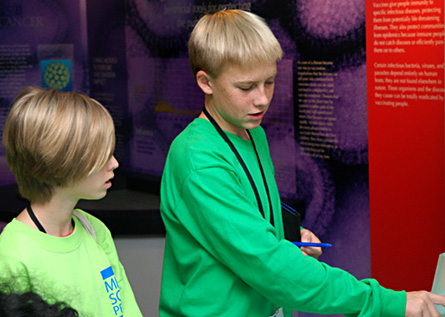Middle school science adventures
Curiosity brings kids to Washington, D.C. for national science competition
 |
|
Christopher Sauer won first place and a twenty thousand dollar scholarship in the 2008 SSP Middle School Program. Here he discusses his project with students from Stuart-Hobson Middle School at the Marian Koshland Science Museum in Washington, D.C. |
Have you ever noticed something — like ants in your backyard, or a smoke from a forest fire, or the moon at night — and thought to yourself “I wonder…?”
These two words can lead to a science adventure and they recently brought 30 middle school students to Washington, D.C. There, in the nation’s capital, these students spent four days participating in scientific challenges. These challenges were part of the Society for Science & the Public’s science competition for middle school students. Five of the students won top prizes, and were announced as winners of the 2008 SSP Middle School Program at an evening awards banquet in Washington, D.C. on October 21.
A lot of science involves wondering about something, coming up with ideas about that thing and then testing the ideas to see what you can discover. Science fairs at school are a good way to explore an idea. This year, more than 75,000 middle school students participated in science fairs at schools across the country. Judges for the SSP Middle School Program evaluated these students’ projects and sent the 30 students who had super-duper projects to Washington, D.C.
Once in D.C., the 30 finalists spent four days working on scientific challenges. One of the challenges was figuring out how an infectious disease like the flu might spread from person to person. Each finalist was also interviewed by the judges. Students were judged on their scientific knowledge, ability to understand new ideas and scientific and analytic thinking. They were also judged on their teamwork, leadership and communication skills. Here are the five top winners of this year’s program:
Christopher Sauer, 13, of Portola Valley, Calif. won first place, a $20,000 scholarship. He was selected as a finalist based on a team science fair project that involved building a simple engine called a magnetohydrodynamic drive. Christopher and his friend came up with the idea after watching a movie about submarines that use this kind of engine. The engine works when electric and magnetic fields thrust seawater out of a chamber, which propels the vehicle forward.
Taking home second place, a $5,000 scholarship, was Katherine Glockner, 14, of Encinitas, Calif. Katherine won a finalist spot for her project that investigated how smoke from the 2007 San Diego County fires affected area grade-schoolers’ lungs. To determine this, she tested the lung function of 149 students in grades four through eight. She also used questionnaires to gather information about each student’s activities during the week of the fires.
Brittany Wenger, 13, of Bradenton, Fla., came in third place, winning a $2,500 scholarship. She created a computer program that combined her interests in neural technology and soccer. Brittany’s program had a soccer team that “learned” as it played. The team eventually got good enough to beat a regular computer soccer team that couldn’t learn.
Winning fourth place — a Vernier LabQuest and $150 in gift cards — was Luke Andraka, 13, of Crownsville, Md. The project that brought Luke to Washington, D.C. began when he noticed that the water where he was whitewater rafting was very orange. Luke learned the waters were very acidic from acid mine drainage, a problem that can sometimes be helped by adding limestone gravel. Luke hypothesized that very tiny pieces of limestone would lessen the water’s acidity better than larger chunks of limestone.
Elizabeth Karron, 12, of Whitefish Bay, Wis., won fifth place, a $500 gift card to Barnes & Noble. Elizabeth investigated two species of duckweed, tiny aquatic plants that often grow together in lakes and ponds. She conducted experiments that showed how the two species compete in environments with small, medium and large amounts of nutrients.
So the next time you find yourself saying “I wonder…,” spend some time thinking about how you might explore your idea further. You never know where your curiosity might lead you — perhaps to Washington, D.C.!
Going Deeper: